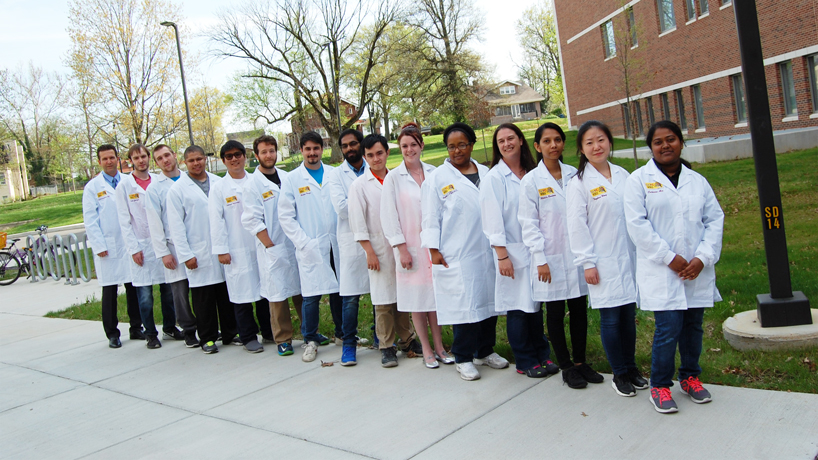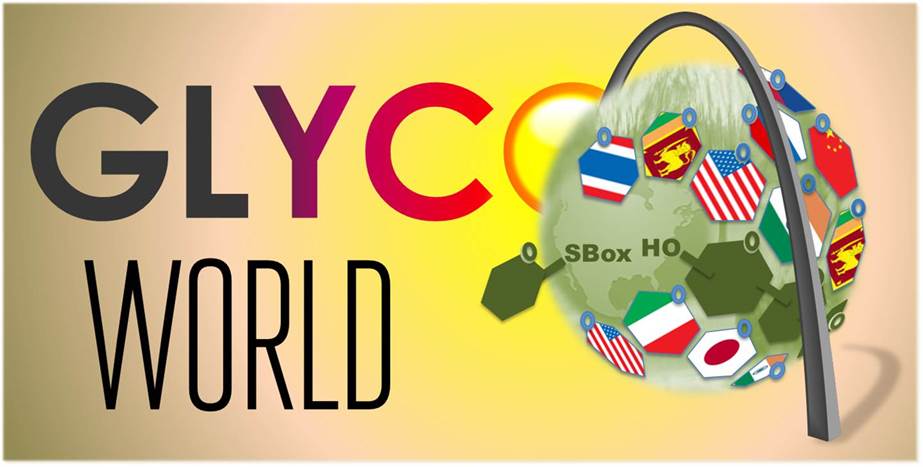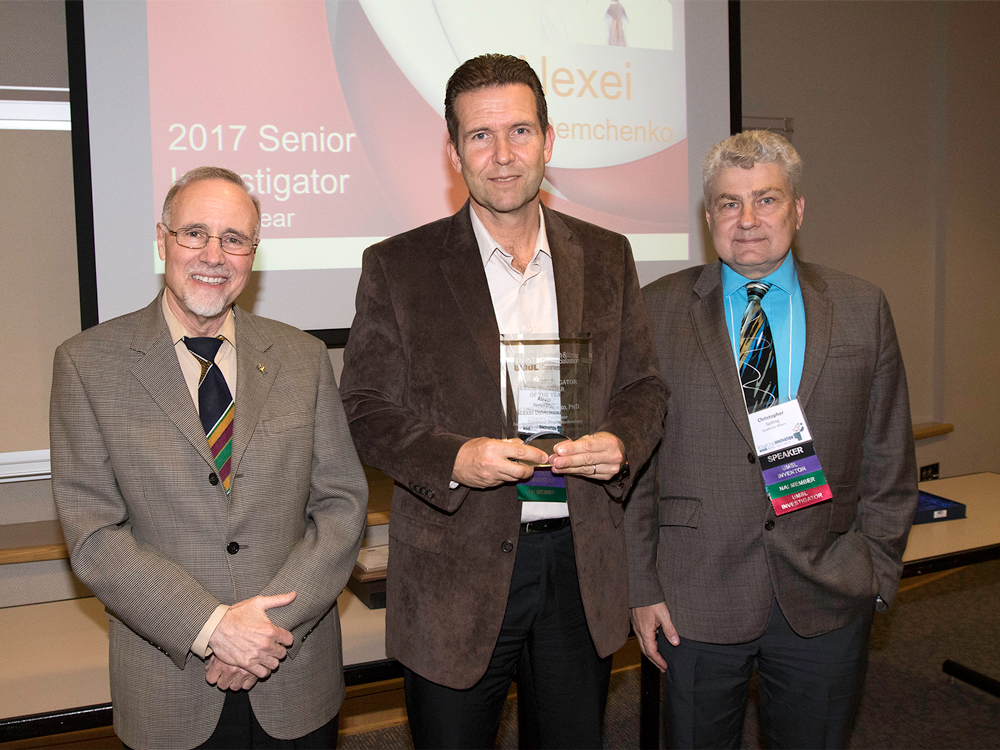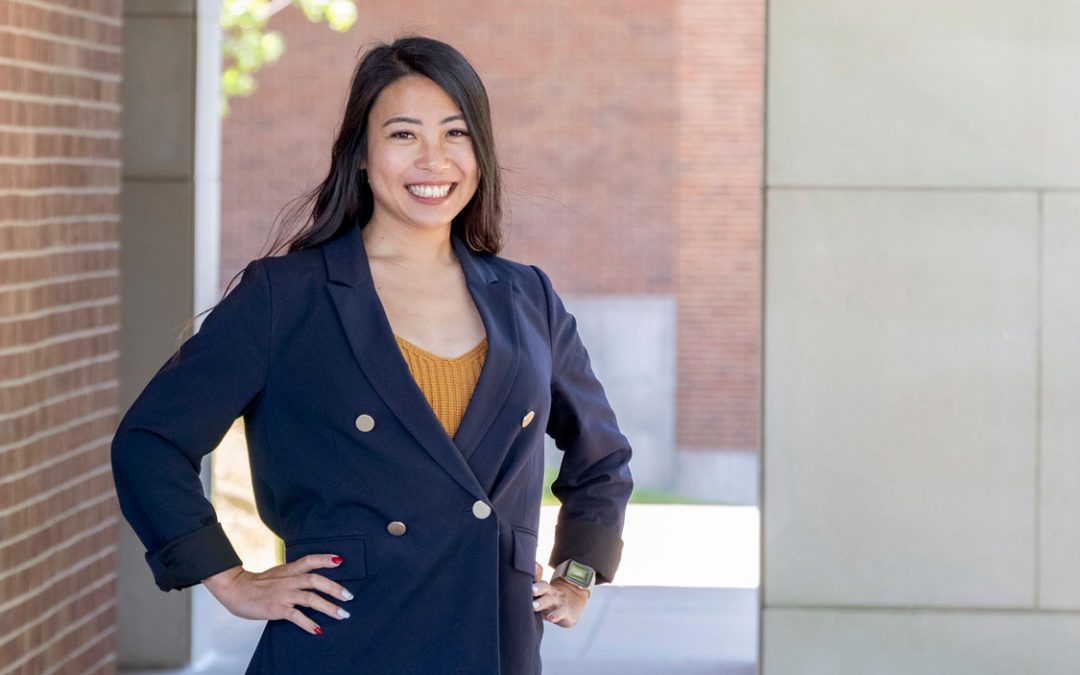
Curators’ Professor of Chemistry Alexei Demchenko (at far left) and his research students make up “Glycoworld,” the name they’ve given their research lab. The team, wearing their Glycoworld lab coats, studies the synthesis and application of carbohydrates associated with cancer and microbial infections and used to develop diagnostics and vaccines. (Photo courtesy of Glycoworld)
Step into Curators’ Professor of Chemistry Alexei Demchenko’s laboratory at the University of Missouri–St. Louis, and you will have entered “Glycoworld.”
Deemed thus by the professor and his research students for its concentration on sugar chemistry, the lab is up to some extraordinary work focused on the synthesis and application of carbohydrates (sugars). They even have their own logo, inspired by the chemical structures they manipulate and the national flags of the students who work in the lab.

The Glycoworld logo used on the website and on the team’s T-shirts and lab coats (Logo courtesy of Glycoworld)
“My students proudly call themselves ‘Glycoworldians,’” Demchenko said. “We even have Glycoworld T-shirts, Glycoworld lab coats and even a Glycoworld clock.”
The culture forms a sense of pride around the work that they consider vital and applicable down to the very creation of life.
“Carbohydrates are involved in many processes and are referred to as the ‘essential molecules of life,’” Demchenko said. “Our life begins with fertilization, which takes place via a carbohydrate-protein recognition. From the building blocks of nature to disease-battling therapeutics and vaccines, carbohydrates have had a profound impact on evolution, society, economy and human health.”
Demchenko’s research is particularly concerned with the health aspect, focusing on the production of carbohydrates associated with cancer and microbial infections. The synthetic versions are used for the development of diagnostics and vaccines.
But synthesizing carbohydrates isn’t so easy.
“Although carbohydrates are so desirable for the biological and medical communities, these molecules are very challenging targets for chemists because of the need for functionalization, protecting and leaving group manipulations and controlling anomeric stereoselectivity.”

Chancellor Tom George (at left) and Vice Provost of Research Chris Spilling (at right) present Alexei Demchenko with UMSL’s 2017 Senior Investigator of the Year award last month at a ceremony concluding Research and Innovation Week on campus. (Photo by August Jennewein)
Basically, it’s hard to control how the carbohydrates react and bond to each other or other classes of compounds like proteins. But even though it’s difficult chemistry, it’s important work because of the modifications it allows and the possibilities those modifications offer.
“Only the chemical synthesis can provide direct access to unnatural mimetics that attract rising interest due to their therapeutic or diagnostic potential,” Demchenko said.
“Rising interest” is certainly an understatement. Continuously since 2005, Demchenko’s research has found funding from many different parties, including the National Institute of Health, the National Science Foundation, Pfizer, Mizutani and more.
The research also earned him UMSL’s 2017 Senior Investigator of the Year Award, presented to Demchenko during last month’s Research and Innovation Week on campus.
Additionally, Organic & Biomolecular Chemistry, a high-profile academic journal, gave Demchenko’s research extra attention, making it the front cover of the January 2017 issue.
Featuring a fox in a box and the Glycoworld logo, the cover is a clever play on the chemistry it represents. The fox and box are inspired by the “functional leaving groups” or groups of atoms used to manipulate the chemical structure of a carbohydrate and its reactivity.

The front cover of Organic & Biomolecular Chemistry’s January 2017 issue featured Demchenko’s research and a fox in a box, playing on the OFox and OBox “leaving groups” or groups of atoms Demchenko’s lab created to modify carbohydrates. The art was originally sketched by UMSL grad and Glycoworldian Salvatore Pistorio and adapted into a watercolor piece by artist Fabia D’Amore-Krug. (Photo courtesy of Royal Society of Chemistry)
“The first leaving group we developed at UMSL was based on a benzoxazole, and since it was connected to sulfur (S), we called it the SBox,” Demchenko explained. “Then, a later variant was called the OBox because it was connected to an oxygen (O). In this paper we present our latest variant. It’s fluorinated (F), so we call it the OFox, but it is not a direct abbreviation; it just sounded fun.”
The cover was first sketched by recent UMSL and Glycoworld graduate Salvatore Pistorio. The rough sketch was then handed off to Demchenko’s colleague and artist friend Fabia D’Amore-Krug, who did her own sketch in pencil, then pen and created the final piece in watercolor.
In total Demchenko has more than 150 published academic articles and gives about 10 to 12 lectures a year. His students deliver about the same number of posters and talks at conferences as well.
“While I have the expertise, leadership and motivation necessary to successfully supervise the research program, it is my students who actually do the magic,” said Demchenko, humbly. “I have a very well-trained and highly motivated research team that is ready to undertake the current research and face new challenges. They are great, all of them!”
And to thank his team for their dedication and hard work, Demchenko said there’s no better way than to “let them have a little fun,” naming the lab, designing the logo together and giving them T-shirts to wear proudly and presenting them with a Glycoclock when they graduate.
For more information on Glycoworld, visit the homepage. You can also follow Demchenko on Twitter.















